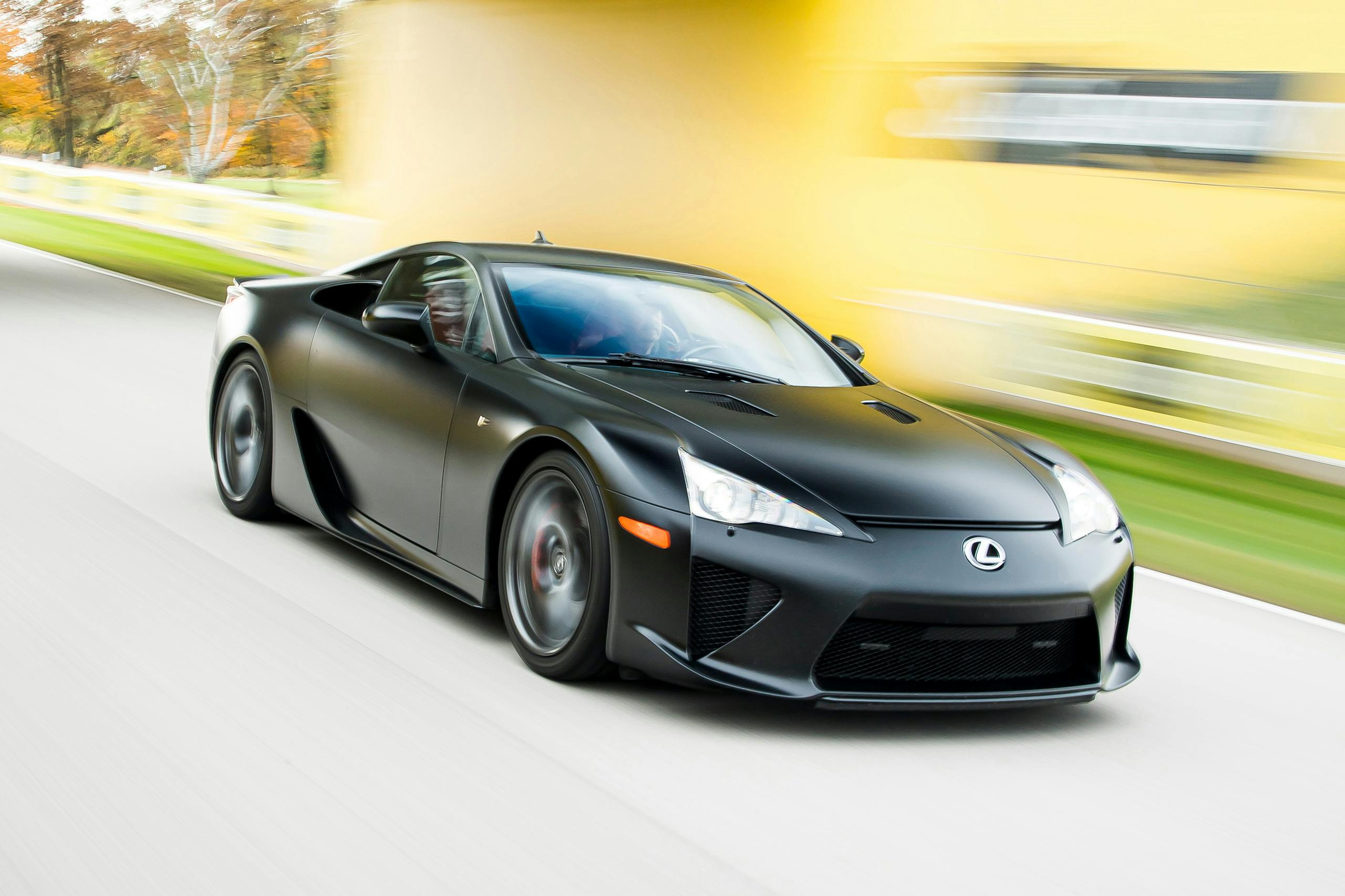Media | Articles
Your handy 2010–12 Lexus LFA buyer’s guide
What are the odds you’re in the market for a Lexus LFA? If we’re honest, slim. Toyota’s flagship offering enjoyed a 500-unit production run over a brief two years and lacks the prestige of its counterparts from Germany or Italy—but this carbon-fiber, V-10-powered monster is a treasure hiding in plain sight. If you can find an LFA, and you have the cash to afford it, how could you possibly resist?
Production timeline
2000s
Since the LFA’s production run is difficult to document, let’s instead discuss the genesis of the model. The LFA’s story starts back in 2000, when Lexus chief engineer Haruhiko Tanahashi started on a blank-check project to make a supercar incorporating the latest in high-tech materials and assembly methods. By 2001, Toyota’s veteran test driver Hiromu Naruse helped engineers draft the vehicle parameters, a list which reportedly included 500 must-haves. The following year added a third and very important manager to the LFA program: Akio Toyoda. With Toyoda’s clout, you’d expect that the LFA had nothing but blue skies in its future—and, for a while, that estimation proved true.
The first LFA prototype greeted the world in June 2003, and by October of 2004 an LFA prototype was ready for test sessions at Germany’s famous Nürburgring Nordschleife. As of early 2005 the LFA was still slated to be constructed out of aluminum, but that changed in 2007 when a new, somewhat larger vehicle debuted wearing the now-famous carbon-fiber-reinforced-plastic body. By early 2008 we got a look at an LFA roadster concept, which of course never made production.
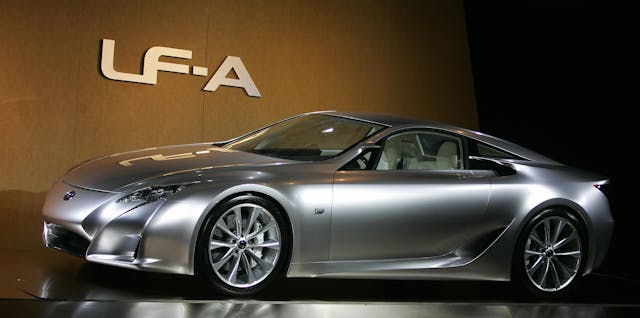
Starting in May of 2008, the LFA was campaigned four times at the grueling 24 Hours of Nürburgring endurance race. This four-year effort was to ensure the LFA satisfied Lexus’ standards for durability and performance, and it’s been said that Akio Toyoda joined the race team for the 2009 season.
2010
Now halfway into the LFA’s racing career, the $375,000 production-spec LFA began to roll off the lines at Toyota’s Motomachi factory. Taking a page from Mercedes’ AMG division, Toyota assigned a single builder to each V-10 engine, who was responsible for assembling the mill from start to finish. Lexus anticipated that a maximum of 20 LFAs could be made per month in Motomachi.
Marketplace
Buy and sell classics with confidence
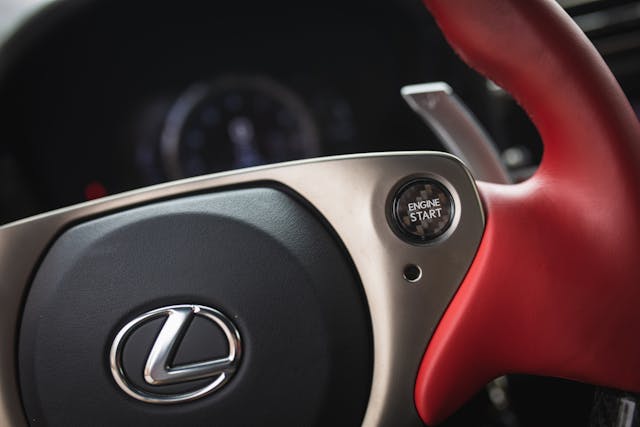
The sheer range of bespoke options means that LFA color palettes varied widely. Lexus offered three wheel options, six brake-caliper colors, and 28 off-the-shelf exterior colors. (Customers could also specify a paint-to-match color of their choosing.) The interior offered a similar bevy of aesthetic possibilities, as owners could customize both the front and rear colors of the seats, the stitching, steering-wheel leather, carpet, headliner, door cards, console, and instrument panel. Each LFA left the assembly line with a brushed-metal commemorative plaque bearing its serial number. These vehicles are supposedly documented by Lexus, so future owners can learn more about the birth of their respective LFAs.
2011
The extremely rare Nürburgring edition was made this year, and included aerodynamic tweaks, an extra 10 horsepower, and a more aggressive tune for the gearbox. While the “regular” LFA lapped the famous ‘Ring in 7:38, this package blew the doors off that time with a stunning 7:14. This was, at the time, the record lap for a production car at the Nürburgring Nordschleife; but the cost for these accolades and benefits was a hefty $70,000, and production was limited to 50 units.
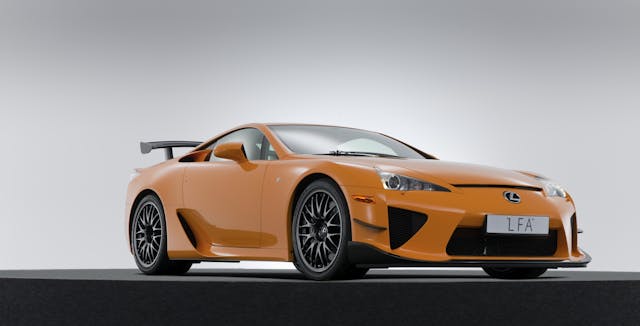
2012
Exactly two years after production began, the final LFA rolled off the Motomachi assembly line. It was finished in white and had the additional honor of being the final Nürburgring edition.
Before you buy
There is a purity of engineering and a visceral performance attitude to the LFA that is difficult to match, and most people who own one appreciate that. With the high-end construction and track-ready personality, however, must come a willingness to maintain the vehicle to Lexus’ high standards. While service history for an LFA may not be as crucial as documentation for an Italian exotic, any LFA lacking service records from a Lexus dealership should give you pause—but likely nothing more, as checking here for a service history might ease a buyer’s concerns.

That said, keeping a Lexus LFA in top form becomes rather expensive if items beyond ordinary consumables suffer damage or deterioration. Take, for example, the $9500 KYB dampers, the $3800 carbon-ceramic brake rotors, the $8000 transmission bell housing, or a replacement V-10 long-block for the princely sum of $88,000. Collision repair is similarly injurious to one’s pocketbook: A new windshield is $9000, replacement bumpers or fenders are $20,000 (each), and even the bespoke “F” emblem on the fenders costs $5600.
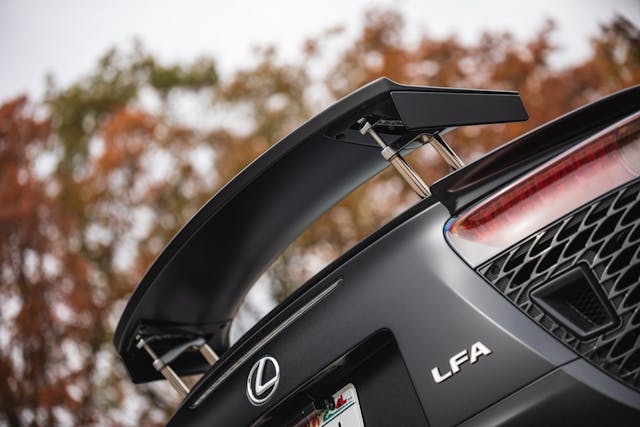
The price tags listed above underscore the need for a pre-purchase inspection if you harbor any concerns with the condition of the LFA in question. Since the best place to put an LFA on a chassis lift will be the service department of a Lexus dealership, inquiring there for said inspection is likely a wise choice. Nobody else knows this vehicle better, so be warned if you wish to take the risk by relying on only a modest visual inspection and a running of the VIN through a service like Carfax.

Since LFAs are made from carbon fiber and aluminum, rust isn’t likely to be an issue, but if any corrosion is found within the undercarriage, factor the cost of repairs into your counteroffer. Also note that, considering the exotic materials used in construction, the odds of any collision repair being performed by an unqualified facility is highly unlikely. Much like the body, the leather-lined interior should look like new, but look up close for an errant scuff or scratch on the LFA’s custom-crafted leather interior. Any other issues unique to an LFA are not well known, so relying on your nearest Lexus dealership for assistance should be considered mandatory.
Valuation
Because of the LFA’s rarity, the Hagerty Valuation team has limited insight into recent transaction prices, so please check here for the most up-to-date values. With limited production comes a smaller data set, but LFAs in #1 (Concours) condition are worth $440,000, significantly more than the original MSRP of $376,000. The even-rarer Nürburgring version (which accounts for only 10 percent of LFA production) is worth about twice as much as a base model: one sold for $912,500 in March of 2019 and another for $918,500 that January. The odds that a LFA Nürburgring version will break the $1 million mark in the near future are high.
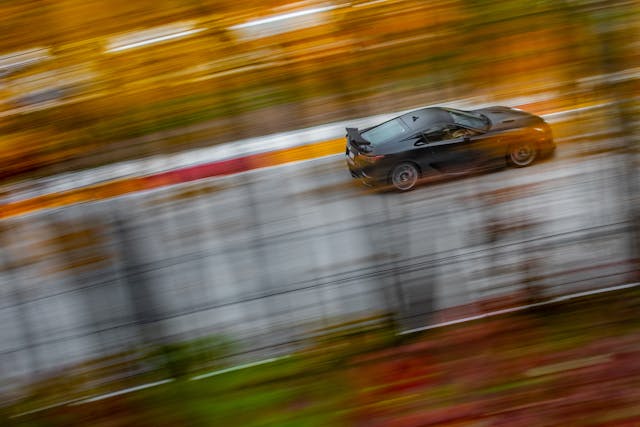
While our LFA pricing data runs back to 2017, the model’s value hasn’t changed in the last four years. If this comes as a surprise, consider again the LFA’s 500-unit production run, the brand loyalty of Toyota/Lexus fans, and the subsequent lack of LFAs appearing for sale. Hagerty quote data on the LFA is similarly thin: Our sample size comprises of only 9 policies issued in the last three years. There’s clearly not enough data to know who’s really interested in Toyota’s flagship supercar, but none of that should stop you from considering an LFA purchase. Well, provided you are lucky enough to find one for sale.













